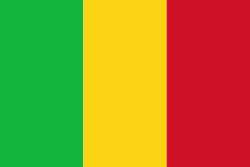Goundam Cercle (Cercle de Goundam)
Goundam Cercle is a second-level administrative subdivision (cercle) of the Tombouctou Region in northern Mali. Its administrative center is the town of Goundam, although the most populous commune is Tonka. In the 2009 census, the cercle had a population of 150,150.
Although Goundam Cercle extends far into the north of Mali, the entire northern two thirds are covered by the inhospitable Sahara Desert. In the south, seasonal lakes and rivers along the northern edge of the Inner Niger Delta provide a meager living for the population, mostly occupied in pastoralism, farming, and fishing. The population is Tuareg and Maure nomads in the vast north, with settlements of Fula people, Songhai people, and Bozo people in the far south of the cercle. Seasonal lakes in this area include Lake Faguibine, Lac Télé, Lac Fatil and Lac Oro. There is an airport at Goundam, and a highway running towards Mopti far to the southwest and east to the regional capital of Timbuktu.
During the Tuareg rebellion of 2012, the government of Mali lost control of the northern part of the country, which was declared independent from Mali altogether as part of the breakaway state of Azawad by the National Movement for the Liberation of Azawad (MNLA) on 6 April 2012. The MNLA government was expelled from the region after June 2012, and the area continued under control of various militias and Islamist organizations.
Goundam Cercle contains sixteen communes:
* Adarmalane
* Alzounoub
* Bintagoungou
* Douékiré
* Doukouria
* Essakane
Although Goundam Cercle extends far into the north of Mali, the entire northern two thirds are covered by the inhospitable Sahara Desert. In the south, seasonal lakes and rivers along the northern edge of the Inner Niger Delta provide a meager living for the population, mostly occupied in pastoralism, farming, and fishing. The population is Tuareg and Maure nomads in the vast north, with settlements of Fula people, Songhai people, and Bozo people in the far south of the cercle. Seasonal lakes in this area include Lake Faguibine, Lac Télé, Lac Fatil and Lac Oro. There is an airport at Goundam, and a highway running towards Mopti far to the southwest and east to the regional capital of Timbuktu.
During the Tuareg rebellion of 2012, the government of Mali lost control of the northern part of the country, which was declared independent from Mali altogether as part of the breakaway state of Azawad by the National Movement for the Liberation of Azawad (MNLA) on 6 April 2012. The MNLA government was expelled from the region after June 2012, and the area continued under control of various militias and Islamist organizations.
Goundam Cercle contains sixteen communes:
* Adarmalane
* Alzounoub
* Bintagoungou
* Douékiré
* Doukouria
* Essakane
Map - Goundam Cercle (Cercle de Goundam)
Map
Country - Mali
 |
|
| Flag of Mali | |
Present-day Mali was once part of three extremely powerful and wealthy West African empires that controlled trans-Saharan trade: the Ghana Empire (for which Ghana is named), the Mali Empire (for which Mali is named), and the Songhai Empire. At its peak in 1300, the Mali Empire was the wealthiest country in Africa, covering an area about twice the size of modern-day France and stretched to the west coast of the continent. Mali was also one of the wealthiest countries on earth, and its emperor at its zenith, Mansa Musa, is believed to be possibly the wealthiest individual in history. Besides being an economic powerhouse, medieval Mali was a centre of Islam, culture and knowledge, with Timbuktu becoming a renowned place of learning with its university, one of the oldest in the world still active. The expanding Songhai Empire absorbed the empire in 1468, followed by a Saadian army which defeated the Songhai in 1591. In the late 19th century, during the Scramble for Africa, France seized control of Mali, making it a part of French Sudan. French Sudan (then known as the Sudanese Republic) joined with Senegal in 1959, achieving independence in 1960 as the Mali Federation. Shortly thereafter, following Senegal's withdrawal from the federation, the Sudanese Republic declared itself the independent Republic of Mali. After a long period of one-party rule, a coup in 1991 led to the writing of a new constitution and the establishment of Mali as a democratic, multi-party state.
Currency / Language
| ISO | Currency | Symbol | Significant figures |
|---|---|---|---|
| XOF | West African CFA franc | Fr | 0 |
| ISO | Language |
|---|---|
| BM | Bambara language |
| FR | French language |















